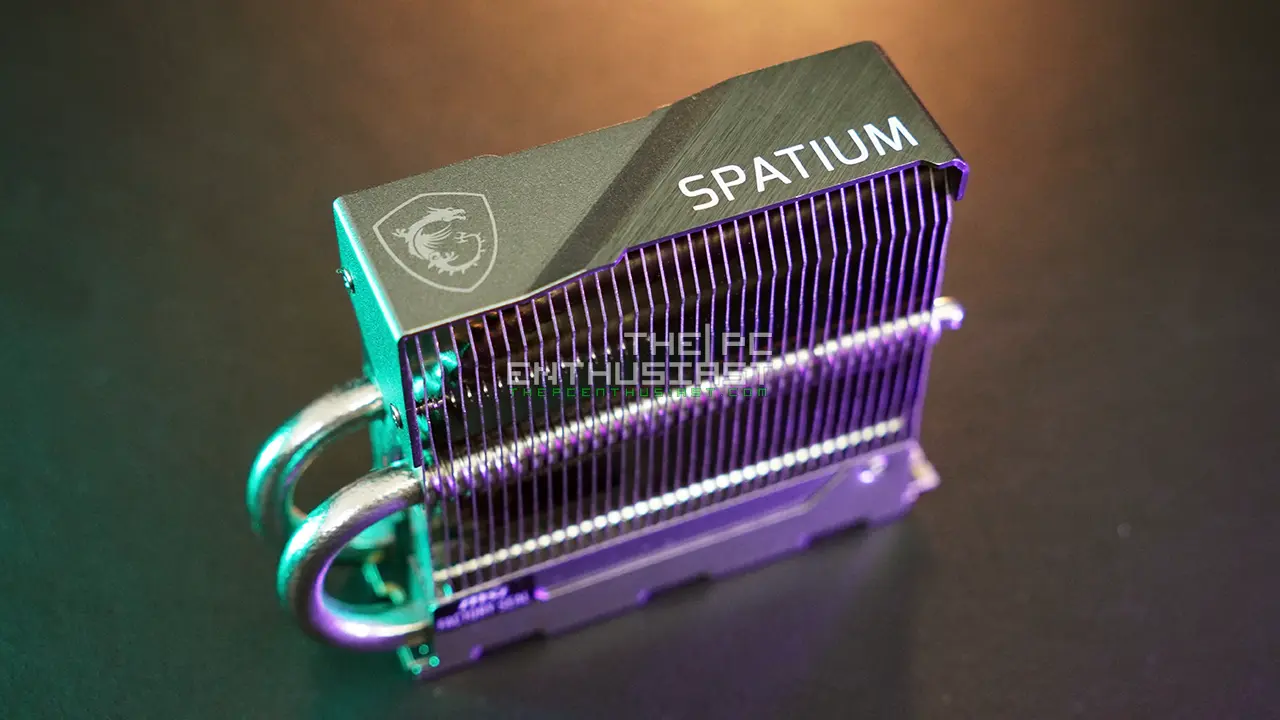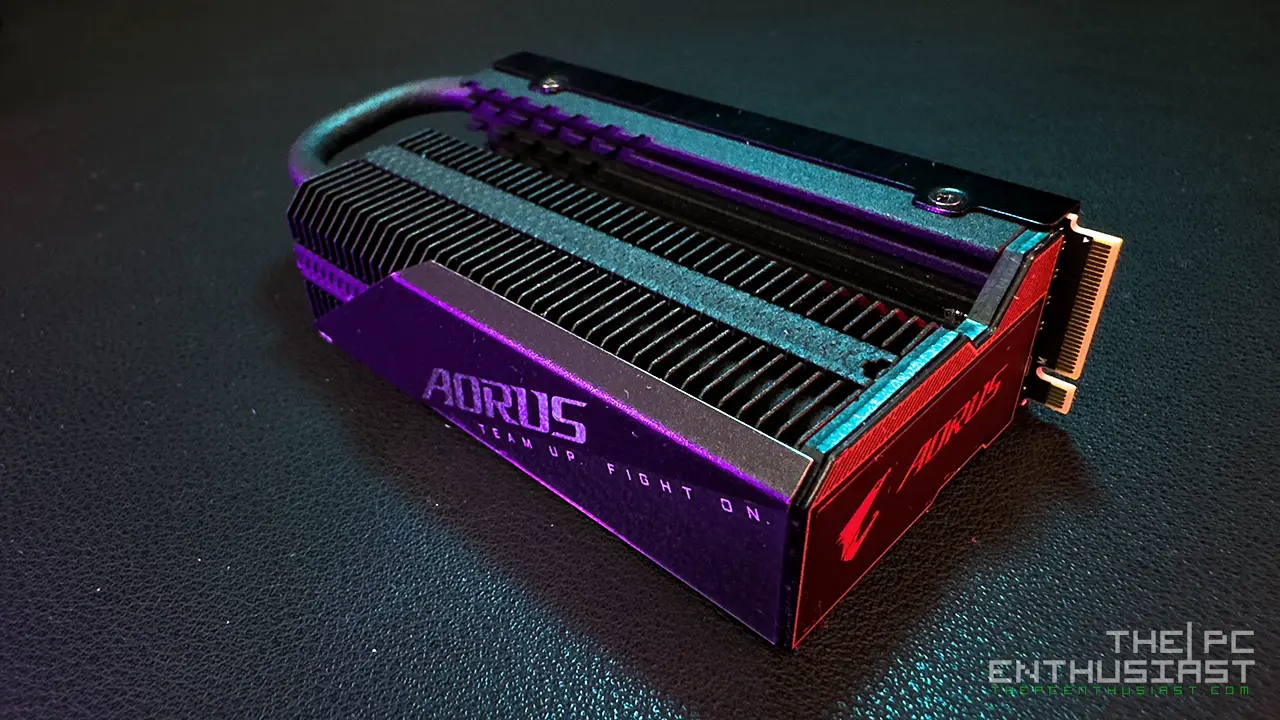Today, we are checking out Lexar’s latest portable SSD, the Lexar SL500. Announced in March 2024, the SL500 uses a USB 3.2 Gen2x2 interface and can achieve up to 2,000MB/s sequential read and 1,800MB/s sequential write speeds. This portable SSD is slim and lightweight and can be used with multiple devices and operating systems. Lexar is also marketing the SL500 to iPhone 15 Pro and Pro Max users since you’ll need an external drive for 4K ProRes video recording. If you’re in the market for a portable SSD, stick around and continue reading our Lexar SL500 review below and find out how it performs.
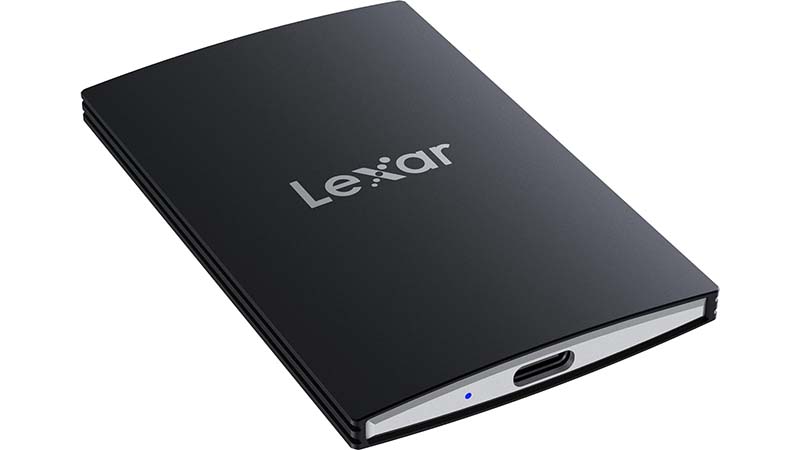
Lexar SL500 Portable SSD 2TB Capacity Review



The Lexar SL500’s packaging is simple, similar to most SSDs. It has a professional-looking all-black color theme. The drive’s capacity is uniquely and boldly printed on the left side, with the speed on the right side. There’s also an indication that it uses a USB 3.2 Gen 2×2 interface, which is capable of up to 20Gbps of transfer speed.
Additional information and some fine prints are at the back. The box includes the SL500 portable SSD and a USB-C to USB-C cable. There’s no USB-C to USB-A adapter included, but many modern devices, laptops, and motherboards have USB-C, regardless of the interface’s speed.
The SL500 Portable SSD
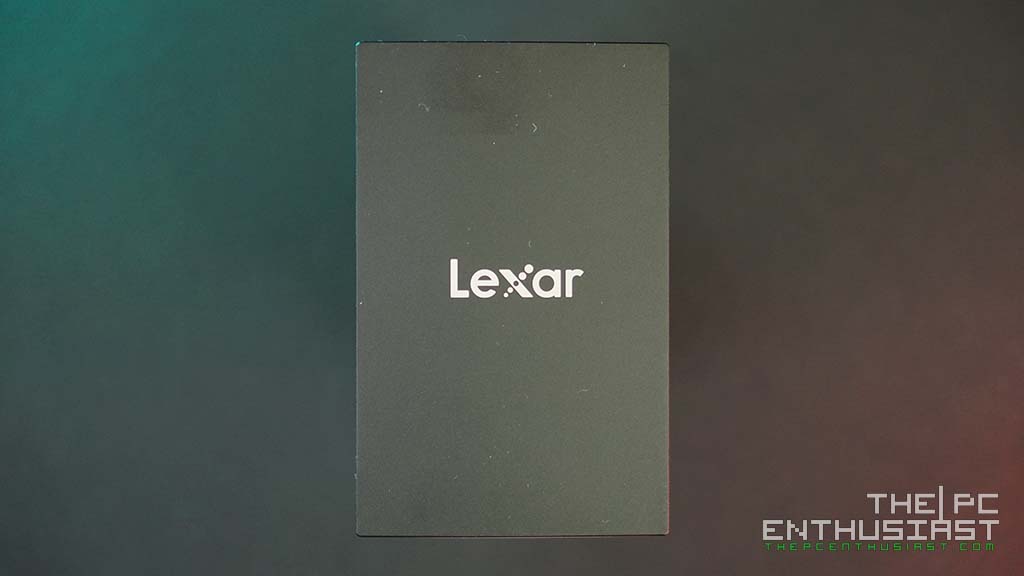

Lexar’s SL500 portable SSD is rectangular, measuring 85mm in length, 54mm in width, and 7.8mm in thickness. It weighs only 43 grams, making it a slim and lightweight device.
The drive’s design is rather plain and simple. The enclosure is aluminum, but it doesn’t have an IP rating. So, I assume this is not dust—or water-resistant at all, and I’d avoid it getting wet or dirty.
SanDisk’s Extreme (Pro) V2 portable SSDs are IP 55 rated, while Samsung’s T7 Shield is IP 65 rated. While many of Lexar SL500’s competitors have better design, aesthetics, and protection, they are also a bit more expensive. SSD prices tend to fluctuate, and sometimes, manufacturers adjust the pricing to compete better.
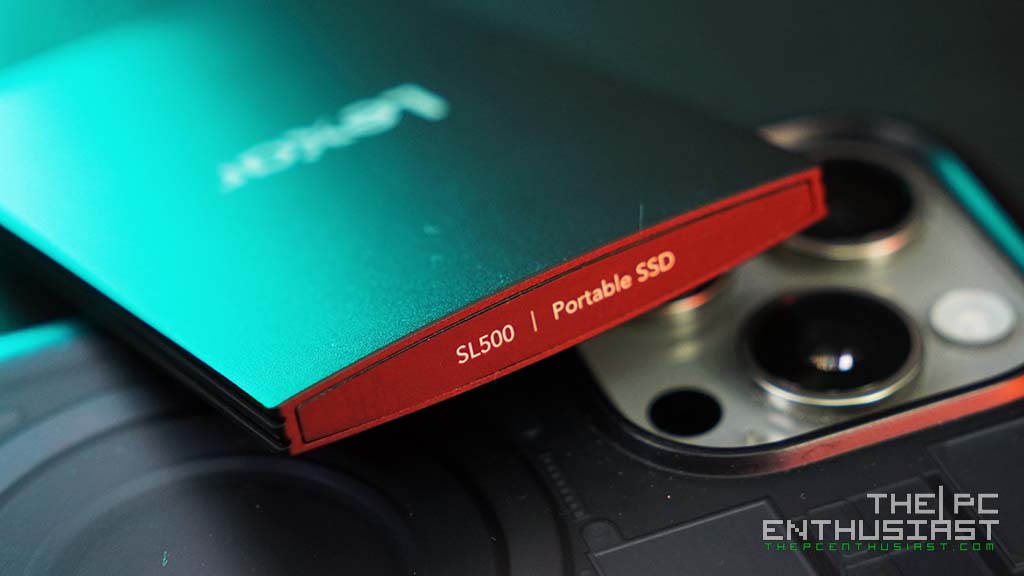

The name of Lexar’s device is printed on one side. Meanwhile, the USB-C port and a tiny blue LED indicator are located on the opposite side.
Lexar uses a Longsys / YMTC 128-layer 3D TLC NAND flash in the SL500 and a Silicon Motion SM2320 as its controller. It is not my first time encountering a Silicon Motion controller and a Longsys-branded YMTC NAND flash. Lexar is also using Longsys NAND flash on its SSDs, like the Lexar NM790, although those are faster 232-layer 3D TLC NAND flashes.

Here’s a size and physical comparison of Lexar’s SL500 and Crucial X10 Pro portable SSDs. Both are capable of up to 2,000MB/s sequential speeds, which basically makes the Crucial X10 Pro portable SSD one of Lexar’s direction competitors.
USB Speeds
To date, there are several USB speeds, and the naming scheme can be confusing, so I’ll give you a simple explanation.
- USB 4 offers up to 20 GB/s or 40 GB/s (max) of transfer speed.
- USB 3.2 Gen 2×2 offers up to 20 Gbps or 2,000 MB/s of data transfer speed.
- USB 3.2 Gen 2 offers up to 10 Gbps or 1,000 MB/s of transfer speed. USB 3.2 Gen 2 is also known as USB 3.1 or USB 3.1 Gen 2 before.
- USB 3.2 Gen 1 offers up to 5 Gbps or ~500MB/s of transfer speed. This interface is previously known as USB 3.0 or USB 3.1 Gen 1.
- USB 2.0 can only transfer up to 480 Mbps (~60 MB/s). That’s why this interface is primarily used for keyboard, mouse, and other non-heavy data transfers.
USBs are usually backward compatible. If a device is capable of up to 2,000 MB/s of transfer speed but is connected to a USB 10Gbps or even slower interface, the connection will limit the transfer speed.
Meanwhile, if the device is only capable of up to 1,000MB/s and is connected to a faster interface, like USB 4, its transfer speed will stay the same since 1,000MB/s is its maximum potential.
So, to take full advantage of a portable SSD’s speed, it’s best that one of your devices also has the matching interface.
Lexar SL500 PSDD Specifications
| Capacity | 2TB |
| Interface | USB 3.2 Gen2x2 |
| Performance | Speed up to 2000MB/s read, up to 1800MB/s write |
| Operating Temperature | 0°C ~ 50°C |
| Storage Temperature | -40°C ~ 85°C |
| Dimension (L x W x H) | 85mm x 54mm x 7.8mm (the thinnest part is 4.8mm) |
| System Supported | 43g |
| System Supported | Mac® OSX 10.6+, Windows® 11/10/7/8, Android 4.4+, Harmony OS |
| Warranty | 5-year limited warranty |
Lexar SL500 2TB Capacity Benchmark Results
In testing the Lexar SL500 portable SSD with a 2TB capacity, I connected it to an MSI MPG X670E Carbon WiFi motherboard. It has a USB 3.2 Gen 2×2 20Gbps-capable USB-C port, eliminating potential bottlenecking issues. If I connected and tested the Lexar SL500 with a USB 3.2 Gen2 (10Gbps) port, then its transfer speed would be cut in half or limited to around 1,000 MB/s only.
Take note that all graphs below are sorted according to write speed.
AJA Benchmark Results

The AJA system test uses video files to test the drive’s read and write speeds; it’s primarily sequential speed. Lexar’s SL500 reached around 1,961 MB/s of sequential speed and around 1,776 MB/s of sequential write. Although it didn’t reach the exact advertised speed, those are still very close and acceptable.
AS SSD Benchmark Results

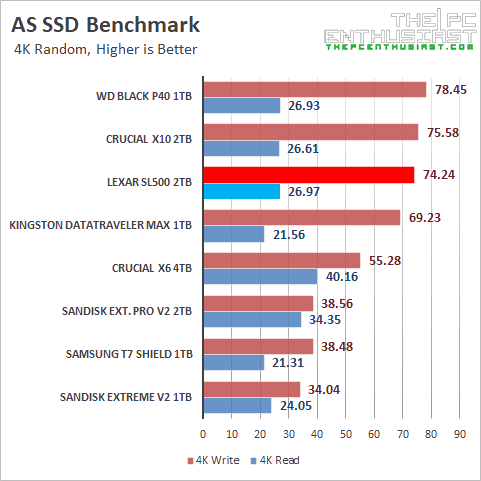
The Lexar SL500 has an impressive sequential read speed similar to what I got in the AJA test system. Its read and write speeds are also neck and neck with Crucial’s X10 Pro portable SSD.
The random read and write speeds are also quite impressive, at least for this specific benchmark test.
ATTO Disk Benchmark Results

In the ATTO Disk benchmark test, the Lexar SL500 reached 2,000 MB/s sequential read. Although its sequential write speed is 20MB/s shorter than its advertised 1,800 MB/s. Nevertheless, it is still an acceptable result.
Again, we can see that the Crucial X10 Pro is neck and neck with the SL500. There are also other portable SSDs that are capable of USB 20Gbps speed. The WD Black P40 and SanDisk’s Extreme Pro V2 are some of the competing portable SSDs in the market.
CrystalDiskMark Benchmark Results


In the CrystalDiskMark sequential test, Lexar’s SL500 portable SSD slightly exceeded its advertised speeds. It reached 2,130 MB/s of sequential read and 1,908 MB/s of sequential write.
While most of these SSDs or portable SSDs have impressive sequential read and write speeds, their random transfer speeds are slower. If you copy a folder containing different types of files and sizes, transferring those files will take longer than copying a compressed or media file.
Nevertheless, despite showing not-so-high numbers compared to their sequential speeds, these SSDs are still significantly faster than hard disk drive’s transfer speeds.
PCMark 10 Data Drive Benchmark Results

PCMark 10’s Data Drive benchmark is designed to test drives that store files rather than applications. It can also be used with NAS drives, USB sticks, memory cards, and other external storage devices.
This test shows that the Lexar SL500, Crucial X10, and SanDisk Extreme (Pro) portable SSDs are in the same performance bracket. If you’re wondering why the WD Black P40 got a much better score and bandwidth than the other 20Gbps-capable portable SSD, it may have something to do with its form factor and design.
The WD Black P40 has a gaming-centric aesthetic and a rugged design. Its larger and thicker aluminum body, which also acts as its heatsink, is one reason why it got a slightly higher score. It can operate for a more extended period while keeping its temperature under control.
Real-World Copy Test


I did several copy tests. First, I copied the compressed installer of the 3DMark benchmark suite. It’s about 9GB+ in size. The first screenshot on the left shows the first copy test with about 9GB capacity.
Meanwhile, on the second screenshot (right side), I copied 6 of those 3DMark installers with a total capacity of 50GB+. As you can see, it was able to copy a large file with ease.
I have yet to go beyond 50GB+, and I’m sure it will slow down at some point past its limit. Also, if I copied a 50GB folder containing random files with different sizes and file types, the result would be different. Expect that it would be slower to copy those random files than copying compressed or media files. You’ll see the graph or status bar going up and down.
Lexar SL500 Portable SSD Review Conclusion
When it comes to performance, the Lexar SL500 portable SSD delivers. It was able to reach its advertised speeds and has been pretty consistent. Copying/transferring files to and from the SL500 was easy, and I didn’t encounter any issues.
I could also copy and transfer files and record 4K ProRes video with my iPhone 15 Pro Max. Unfortunately, I could not benchmark it with the iPhone 15 Pro Max since I couldn’t find a reliable app or way to benchmark the SL500 with the iPhone.
By the way, the iPhone 15 Pro and 15 Pro Max are only capable of up to 10Gbps transfer speed, so they’re not fully utilizing the SL500’s potential speed. Nevertheless, since my desktop PC has a USB 3.2 Gen2x2 port, I can still take advantage of its speed.
The only thing I would nitpick about the SL500 is its build quality and aesthetics. While it is nice that it is slim and compact, it lacks water resistance and dustproofing. I wouldn’t use the SL500 in harsh environments. I also don’t know how shock or fall-resistant the SL500 is. The housing feels a bit thin, and I think it’s best to use it in an office environment instead of outdoors.
Finally, there’s no doubt that the Lexar SL500 portable SSD was able to deliver when it comes to performance. Price-wise, it has gone down a bit since its initial release. But there are plenty of USB 20Gbps-capable portable SSDs in the market.
Competition is tough, and one way for Lexar to outshine its competition is to keep the pricing low and very competitive. If you ever spot an SL500 at very attractive pricing, I say it’s worth considering or buying this portable SSD.
Pricing and Availability
The SL500 Portable SSD is now available in 2TB at $229.99 MSRP and will be available in a 4TB capacity at the end of Q2. For the latest pricing and availability, kindly check the link below.
Shopping options:
Lexar SL500 Portable SSD 2TB is available on Amazon here.
I hope you liked our Lexar SL500 Portable SSD review. ThePCEnthusiast is supported by its readers. When you purchase products via our links, we may earn a small affiliate commission at no extra cost. Thank you for your support!






